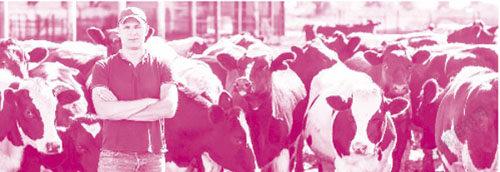German Scientists Potty-train Calves 德國科學家對牛進行如廁訓練




家畜的糞便產生的氣體是溫室氣體的一大來源,為了減少家畜隨地排泄對環境的危害,德國科學家對牛進行了如廁訓練。結果發現,牲畜比人們想的更聰明。
If you can potty-train a child, you can potty-train a calf. At least, that was the theory a group of researchers in Germany decided to test, in a bid to find a solution to the environmental damage caused by livestock waste.
如果你可以訓練孩子使用便盆,你也可以對牛進行如廁訓練。至少,這是一群德國研究員決定驗證的理論,目標是解決牲畜糞便危害環境的問題。
Farmed cattle produce roughly 66—88 pounds of feces and 8 gallons of urine each day and are free to relieve themselves where they please. However, the spread of their waste into the soil can have negative effects on the environment.
在農場飼養的牛每天大約會排出66到88磅糞便和8加侖尿液。它們都是隨地大小便,而它們的糞便滲入泥土中會對環境產生負面影響。
Agriculture is the largest source of global ammonia emissions, and livestock farming makes up more than half of that contribution, the researchers noted in a press release, adding that in Europe, 90% of ammonia emissions come from agriculture.
研究人員在一份新聞稿中指出,農業是全球氨排放的最大來源,其中畜牧業的氨排放量就占了一半以上。據稱,歐洲90%的氨排放量來自農業。
While the ammonia produced from cattle waste doesn’t directly contribute to climate change, when mixed with soil it is converted into nitrous oxide, a greenhouse gas. It also contaminates the soil and local waterways.
盡管牛糞便中產生的氨氣不會直接導致氣候變化,但是氨和泥土混合后會轉化為溫室氣體一氧化二氮。糞便還會污染泥土和當地水道。
The main question for Langbein, an animal psychologist at the Research Institute for Farm Animal Biology (FBN) in Germany, and his team was: “Why shouldn’t (cattle) be able to learn how to use a toilet? Animals are quite clever, and they can learn a lot.” Langbein said in a statement.
德國農場動物生物學研究所的動物心理學家朗本在一份聲明中說道,對于他和他的團隊來說,主要問題在于:“為什么牛不能學會如廁?動物們很聰明,也能學習很多東西。”
The team of scientists from FBN and FLI in Germany and the University of Auckland in New Zealand began to potty-train the calves, in a process they called “MooLoo training”.
來自德國農場動物生物學研究所、弗里茨-利普曼恩研究所和新西蘭奧克蘭大學的科學家團隊開始對牛進行如廁訓練,他們將這一過程稱作MooLoo訓練。
In the first phase of training, the cattle were put in a closed latrine. And whenever they urinated, they were given a reward of either electrolyte mixture or crushed barley.
在訓練的第一階段,牛被關在茅廁里。無論何時尿尿,它們都會獲得電解質溶液或碾碎的大麥作為獎勵。
To encourage calves to use the toilets, researchers also came up with a deterrent. “We first used in-ear headphones and we played a very nasty sound whenever they urinated outside,” said Langbein. “We thought this would punish the animals, but they didn’t care. Ultimately, a splash of water worked well as a gentle deterrent.”
為了鼓勵牛使用廁所,研究人員也想出了威懾措施。朗本說:“我們一開始給牛裝了入耳式耳機,只要牛在外面尿尿,就會播放很難聽的聲音。我們認為這是對動物的懲罰,但是它們卻不在意。最后我們發現,用潑水這種溫和的威懾措施效果不錯。”
The calves were trained for 45 minutes every other day. And after 10 training days, the team had managed to successfully train 11 out of the 16 calves involved in the experiment.
研究人員每隔一天就對這些牛進行45分鐘的如廁訓練。在訓練了10天后,參與實驗的16頭牛中有11頭成功學會了如廁。
The results showed that calves performed at a similar level to children when learning to potty-train, and did better than very young children.
研究結果顯示,牛學習如廁的水平和小孩差不多,而且比幼童表現得更好。
The study showed that it is possible to potty-train calves, and Langbein said he hoped that in a few years all calves would learn to go to the toilet.
研究表明,對牛進行如廁訓練是可行的。朗本表示,他希望幾年后所有的牛都能學會上廁所。
Word Study
livestock /'la?vst?k/ n. 牲畜;家畜
urine /'j??r?n/ n. 尿;小便
ammonia /?'m??ni?/ n. 氨;氨水
emission /i'm??n/ n. 排放物;散發物
latrine /l?'tri?n/ n. 廁所;(尤指)茅坑,便坑
barley /'bɑ?li/ n. 大麥;大麥粒
deterrent /d?'ter?nt/ n. 威懾因素;遏制力

